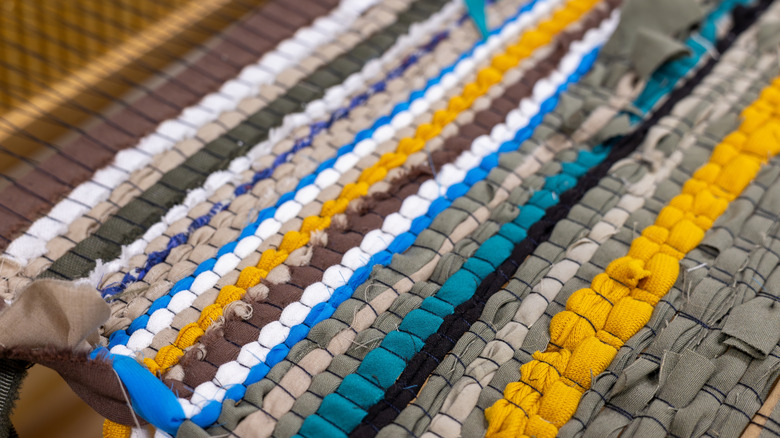Never Buy Twine Again By Using Fabric Scraps You Already Own
We may receive a commission on purchases made from links.
Fabric scraps are unavoidable if you sew, quilt, or upholster on the regular. Your torn pillowcases and socks without mates are textile waste, too. Items like these are a no-go for most recycling bins, so they often end up in the trash. Thinking creatively can help you divert these materials from landfills. It can also save you money and put a smile on your face. Instead of throwing out fabric scraps, you can use them to make bespoke baskets or you can even create one-of-a-kind textile art for your home. If you'd prefer a more utilitarian repurposing project, turn scraps into twine you can use in your home and yard.
Making twine is an ideal way to merge materials that are somewhat stretchy with those that have minimal stretch. It's also a lovely way to combine fabrics of different colors and patterns. Teaming lightweight scraps with heavyweight ones can be tricky, so join fabric pieces whose weights are alike if you're new to this type of project.
Unlike many textile projects, twine-making doesn't require a pattern or a sewing machine. You don't need any sewing or weaving knowledge, either. What you do need are a ruler and a cutting tool, preferably fabric shears such as the Singer fabric scissors with comfort grip, or something like the Fiskars 45mm titanium rotary cutter. Use this tool to cut your scraps into similar-width pieces. If you're not sure how wide to go, aim for an inch. Don't fret if your snips aren't perfectly straight. This can add character to the final product.
How to turn leftover textiles into pretty, sturdy twine
Once you have a sizable pile of fabric strips that are roughly the same width, you're ready to twist and braid. Select two long pieces of fabric and knot them together near their top ends. Place something weighty on the knot to keep it from moving around. Then, twist one strand to either the left or the right — whichever feels more comfortable — and lay the twisted strand across the untwisted strand. Twist the second strand in the same direction as the first and lay it across the first strand. Braid the strands together by repeating this twisting and crossing process.
When only an inch or two of a strand is unbraided, grab another fabric strip. Attach this strip to the strand that needs lengthening. You can do this with fabric glue or a few stitches with a needle and thread. Or, just lay the top of the new strip over the bottom of the original strand so the two pieces overlap. Fold the new strip around the original strand, twist, and continue your braiding process. The twisting and crisscrossing will hold the pieces together. When you run out of fabric or think your twine rope is long enough, knot the ends of the strands you've been braiding and snip off any strings or frayed edges. If you'd like, roll this rope into a ball for ease of storage. Then, decide how you might repurpose your twine around the house.
Ways to use homemade fabric twine
Fabric twine is as tough as it is pretty. In other words, it's great for tying up bundles of newspapers, tethering plants to stakes, and other jobs that call for strong string. That said, many of its most exciting uses leverage its rustic beauty. Your twine can be used in place of ribbon to decorate gift-wrapped packages, or to connect the triangular flags of a bunting banner. Try winding it around vases, jars, and picture frames to add color and texture. Or, revamp your curtains with a tassel and twine Dollar Tree DIY.
Crafters love to use fabric twine for low-cost sewing and weaving projects, from boho-style placemats to wearable art such as belts, lanyards, and bracelets. Try using it for the handles of a bag or the piping on a homemade cushion. You can even make it into a Chindi rug that's durable enough for high-traffic areas and washable as well, unlike many mass-produced rugs. There are many ways to do it, including weaving with a loom, crocheting with a jumbo hook, or braiding and twisting like you did to make the twine itself.

